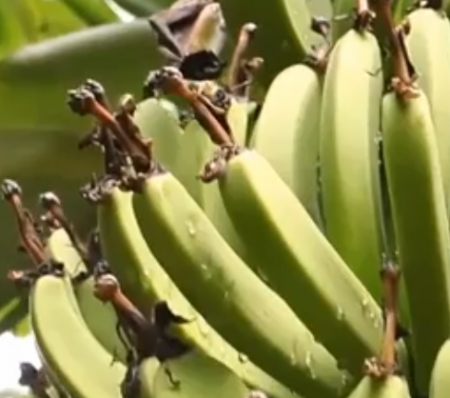June 24, 2018 – I don’t know about your family but in my weekly shopping I may not write down bananas on our list, but I always buy them. They are default fruit. And when you buy bananas at the supermarket, it is rare that you see more than one type. The usual choice is between regular and organic, but the variety of banana is always the same. The one commercial variety, known as the Cavendish, has been the banana of choice for growers around the world since the 1950s when it rescued the industry after the previous variety, Gros Michel, a sweeter and larger variety, was felled by a blight known as Panama Disease.
Panama Disease, caused by a fungus, Fusarium, first emerged in Central America and spread globally. It wiped out the banana monoculture and had growers scrambling to find its replacement which is today’s banana monoculture. You would think growers would have learned from the Gros Michel die off to not put all their eggs in one basket. But today we face the same conditions that felled that banana monoculture. In this case a new variety of Fusarium is at work killing banana plants in Central America while a bacteria is doing the same to plants in East Africa. The industry’s reliance on monoculture is once more leaving it susceptible to a global banana crash.
There is one other thing banana eaters need to know. The fruit you eat is a clone. Cavendish bananas are not bred. All the plants in the commercial industry are derived from cuttings of existing plants. That’s how monocultures are born. And when one plant becomes susceptible to a new disease, or in this case a variant on an old one, then all plants are in danger.
Re-engineering the DNA of the Cavendish banana could be a way out for growers to beat back new threats. A recent British startup, Tropic Biosciences UK LTD, has made this one of its missions using what it calls“cutting edge non-GMO gene editing techniques” to re-engineer the Cavendish. Gilad Gershon, CEO of Tropic Biosciences in a recent interview notes that traditional breeding is not an option which only leaves genetics. Editing the DNA of the banana to fight off bacteria and fungi will not only serve to save the plant, but it also can help the perishable fruit stay fresher longer in transit and on grocery shelves.
Gershon states that the way to do this is to use the genetic re-engineering tool. CRISPR, to remove portions of the Cavendish’s genetic code to create some variations in the variety and see how the altered plants do against fungi and bacteria. Another approach would be to look at other banana varieties which resist the fungi and bacteria and borrow bits of genetic code to insert into the Cavendish DNA.
Gershon doesn’t label the end product of their research a GMO, although it certainly fits the picture. His justification for not using the label is that any substituted DNA is all banana and not code borrowed from another plant species.
Expect CRISPR edited crops to become more prevalent in world food production as the century unfolds. Tropic already is using CRISPR to genetically edit coffee to make the bean naturally decaffeinated. Other bioscience companies are paying attention because using CRISPR means it becomes possible to enhance existing popular foods without having to run the gamut of the anti-GMO movement.








